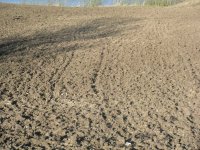dave1949
Super Star Member
More weight and crossing pattern will help.
Looking at the disc pics, I think the disc blades may be worn a good bit judging by the clearance from the frame to the blades. That might affect how aggressively it cuts.
If you could use a chisel plow, then disc, it would help.
Dave.
Looking at the disc pics, I think the disc blades may be worn a good bit judging by the clearance from the frame to the blades. That might affect how aggressively it cuts.
If you could use a chisel plow, then disc, it would help.
Dave.
